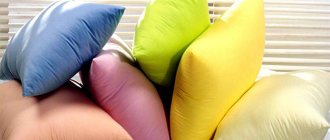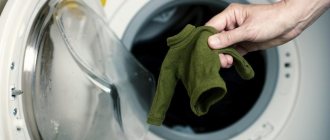Sometimes it happens that a purchased item or material was initially soft to the touch, but after washing it becomes rough, prickly, hard and completely unwearable. Every person wants to feel comfortable in clothes, especially if they have to be in them all day. Your favorite blouse, jacket, dress, trousers are put on the far shelf, but they were in such harmony with other things.
Why does this happen? Sometimes washing conditions are not met. By setting a higher temperature on the washing machine programmer, you can unwittingly ruin the quality of the fabric. Often the situation can be corrected. You will have to try some techniques so that the clothes become pleasant to the body again and do not cause negative feelings.
The first thing we can suggest is to use washing powder, liquid SMS and conditioner intended for this type of fabric, follow the heat treatment and washing regimes. That is, read the label and follow the recommendations.
But there are methods that housewives use successfully. In this article we will reveal the secrets of softening all types of fabrics.
Cotton
The high rigidity of cotton fabric is due to the processing of threads using special glue. To soften the material, you need to wash the item of clothing several times with regular powder, and use conditioner when rinsing. After 2-3 such procedures, the textiles become softer.
Note : Cotton clothing should not be washed at temperatures above +60 degrees, as this may cause the product to shrink.
Washing outerwear with filling
Jackets and down jackets can be washed either by hand or by machine. The general recommendations are the same as for washing simple items, but there are a few subtleties.
To prevent the filler from forming clumps (this applies to natural down and feathers), add several tennis balls to the drum when washing. It is recommended to dry the product on a hanger, periodically distributing the fluff evenly over the lining. Filling made from padding polyester is less prone to forming lumps, but it should also be dried on hangers. Do not use heating devices to reduce drying time.
Denim
An alkaline solution will make jeans soft. To prepare the product, you need to dilute 3-4 tablespoons in one glass of water. The resulting liquid should be poured into the washing machine compartment and washed at a water temperature of +40 degrees. Jeans should be rinsed using fabric softener.
Note : this method is not suitable for processing dark clothes, since such clothes may lighten under the influence of soda.
To soften linen fabrics, it is necessary to soak the items in 5-7 liters of water diluted with 3-5 tablespoons of table salt. Leave the clothes in a container of water overnight and wash them in the morning.
Dilute two doses of conditioner in a basin of warm water and immerse things there for a day. After 24 hours, clothes should be rinsed or washed with conditioner.
Pour acetic acid into a basin of water to a two percent solution and soak the clothes in the reservoir for several hours. Next, rinse the item well several times. If after a set of procedures a sour smell remains, you can wash it.
More information about clothing care can be found from the manufacturer Vulkana.
Synthetic fabric is widely used in everyday life. While inferior to natural fabrics in hygiene, it surpasses them in wear resistance, affordability, and ease of care. In terms of aesthetic properties (color range, quality of fibers) it is equivalent to silk, wool, cotton. But, to preserve these qualities for a long time, you need to know how to wash polyester correctly.
What to do if the bed linen is hard?
during washing, you can add another rinse, in a special compartment for powder, add 1 tablespoon of table salt per liter of water, this will help soften the laundry and reduce water hardness; If you use the drying mode, it is better to choose a temperature much lower than when washing.
Interesting materials:
What is needed to obtain a Schengen visa to Spain? What is needed to obtain a tourist visa? What is needed to obtain a Schengen visa? What is needed to obtain a visa to the Czech Republic? What do you need to apply for a visa to Finland? What is needed to obtain a visa to Greece? What is needed to obtain a visa to Spain? What is needed to obtain a visa to Poland? What do you need to apply for a visa to France? What is needed to obtain a voivodeship visa?
Features of the material
Polyester is a synthetic fabric made from polystyrene. Polystyrene is a product of petroleum refining. Fiber is obtained from the liquid fraction after purification and processing. In the textile industry, it is used to make fabric used for sewing clothes and equipment. According to the characteristics of 100% polyester, it is close to cotton fabric, and in appearance it resembles pure wool.
- wear-resistant;
- does not fade from the sun;
- moisture resistant, dries quickly;
- does not wrinkle when cutting and sewing;
- pleasant to the skin;
- does not absorb odors.
Disadvantages of synthetic products:
- low hygroscopicity;
- high density (rubbed upon contact with skin);
- become electrified;
- attract dust;
- flammable;
- lose their shape at temperatures above 40 degrees.
To improve the quality of the fabric (firmness, elasticity, density), cotton, wool, viscose, and elastane are added to polyester.
The following are sewn from polyester materials:
- thermal underwear;
- sports;
- outerwear;
- home textiles (tablecloths, curtains, bed linen, carpets);
- equipment (backpacks, tents);
- the wrong side of suits, dresses, jackets, coats.
Synthetic fibers are used as filler in down jackets and jackets (holofiber).
What is tulle used for?
The density of tulle is from 15 to 40 grams per square meter. It is used for making ballet tutus, fluffy petticoats (for wedding and ball gowns), as well as woven decorative items: ribbons, bows, artificial flowers, etc. Tulle is also used as a basis for embroidery and crocheting.
Interesting materials:
What types of thinking are used at different stages of Design Thinking? What types of low starts are used in athletics? What types of search are used in ATP? What types of utensils are used to serve cold dishes and snacks? What types of speech does the artistic style use? What types of malt are used in brewing? Which wood is best to use for a bed? What kernel does Windows use? Which oil is best to use for eyelash growth? What oil should you use for hair growth?
How to properly wash things in an automatic washing machine
The water temperature must correspond to that specified by the manufacturer: 30, 40, 60 degrees. It depends on the composition of the fabric. Mixed materials are more resistant to elevated temperatures. You cannot wash it in water temperatures below 20 degrees: the powder will not dissolve. The detergent can be powder or liquid, depending on the type of item being washed.
Washing mode – delicate. Time – 30 minutes. Adding conditioner will make the product softer. Pure polyester can be washed without spinning. The item is laid out or hung, allowing the water to drain. Combined fabrics are wrung out at minimum speed.
How to dye polyester at home
Fabric with such a composition can be dyed, but it is important to note some principles that can significantly affect this process:
- synthetic composition in the fabric: 100% polyester does not lend itself to this procedure;
- it is important to choose the right dye and meet all the requirements for its application and dilution;
- if polyester has been washed several times, the likelihood of it staining increases, since in this case its moisture-repellent properties are reduced;
- The easiest way is to change only the shade, and not the entire color of the product.
The dyeing process itself can be divided into several stages:
- The product is soaked for half an hour in washing powder, and the water should be at 30 degrees.
- Then you should rinse the item in water that contains ammonia.
- Such clothes should be dyed in enamel dishes.
- It is important to immerse the polyester evenly in the paint and strictly adhere to all the requirements specified in the instructions.
- Finally, you need to rinse the item thoroughly until the water runs clear.
- There is no need to wring out the product, but it needs to be hung to dry.
General tips and tricks
Polyester items quickly become dirty due to their ability to attract dust. This is especially true for outerwear, sports and travel equipment. Regular cleaning of products is required. If we generalize the conditions for washing polyester products, they can be divided into 2 groups: how to wash and with what.
By washing
For hand and machine washing, the water temperature should be in the range of 30-40 degrees. Higher heating must be permitted by the manufacturer. Products made from thin polyester are washed in fabric covers.
The washing mode in the machine is automatic – delicate. Spin is allowed at minimum speed. Wash by hand without using brushes, without twisting during spinning.
By choice of product
Wash in cold water without powder, using conditioner and laundry soap. Liquid detergent or powder is dissolved in warm water. Do not use products containing chlorine. The addition of conditioner during rinsing gives clothes antistatic properties.
Ways to clean a blanket
Polyester is often used as a filling for blankets. If you do not trust dry cleaning, then proceed according to the following scheme:
- If the capacity of the drum allows, place the blanket there.
- Pour liquid powder and conditioner into the compartments and start the second rinse.
- Spread the wet blanket on a flat surface and dry it by turning it from side to side.
- The 2-bed blanket is hand washed in the bathtub. After letting it sit for 15 minutes in soapy water, sponge it and rinse.
- Spinning and drying is similar to the method described above.
Subtleties of washing some products
The particularity of washing depends on the density of the fiber weave, additional components to polyester, and the type of product.
Coat
The fabric on the coat is thick. Coats are washed in an automatic machine. Washing temperature – 30 degrees. Processing mode – “delicate”/“synthetic”. An additional rinse is used to completely remove the detergent (washing powder).
Dry flat, on hangers. When wet, iron with a warm iron to smooth out the front and back. When dry, iron through moistened gauze. Mixed fabrics (with wool, viscose) are rolled up after washing. It is recommended to dry clean such items.
Jacket
A polyester jacket is washed inside out. Before this, unfasten the hood, empty the pockets and fasten all the buttons and zippers. Water heating - 30 degrees. Drum operation in “delicate” mode. Spin – up to 400 rpm. Additional rinse. As a detergent - washing powder.
After the automatic machine, the jacket is hung on hangers without turning it inside out. When the inside is dry, dry the top. If the thermal insulation filler is polyester fibers (holofiber), then washing depends on the type of fabric at the top of the jacket:
- The insulated lining is detachable from the jacket. Holofiber is elastic, coiled threads that do not absorb moisture and have good thermal insulation properties. The material is resistant to temperatures up to 90 degrees and chlorine-containing stain removers. Wash the liner as usual, with a spin cycle. Synthetic insulation does not wrinkle and dries quickly. The detergent must have a liquid consistency so that it is completely removed when rinsing. The powdered product is not washed out, retaining the smell of washing powder. The washed item is hung on a rope or hanger. Dries in a few hours.
- The lining with holofiber cannot be detached; the top of the jacket is made of raincoat fabric. The washing mode corresponds to the coating of the product. Water temperature is 45-50 degrees. Using liquid detergent. Spin. The raincoat fabric is resistant to mechanical stress, including the use of brushes during hand washing. Chlorine stain remover will discolor the fabric. Thick fabric is dried in a draft.
- The jacket is covered with membrane fabric. Washing requires careful handling in manual and automatic modes. With the manual method, the water temperature is no higher than 35 degrees. The jacket is soaked in water, gel or shampoo for membrane fabrics is added. Wipe the top with a soft sponge. Rinse. Allow the water to drain and hang it on hangers. After half an hour, dry using terry cloth. Dry completely flat on a hygroscopic fabric. In the machine, the machine is set to a “delicate” mode, without spinning and drying, the temperature is 40 degrees, a liquid product is added. Dry the product as if washed by hand.
- Polyester covering. Machine and hand wash at a temperature not exceeding 40 degrees, with liquid detergent. Manual spinning, without twisting. Set the machine to minimum speed and turn off the drying mode. The jacket is dried on hangers, avoiding direct sunlight and proximity to heating devices.
- Bologna top. Items are washed by hand, without using brushes or twisting. The detergent is liquid. Water temperature - 40 degrees. The machine can be washed in a protective cover. Drying in the shade.
Care of the jacket must be carried out in accordance with the markings on the label. The quality of holofiber is checked using a certificate.
Down jacket
Winter clothes can have a synthetic top, filling, and lining. The combination of down jacket elements depends on the manufacturer and model.
A down jacket with natural filling (down, down-feather, feather), coated and lined with polyester, can be washed by hand or in an automatic machine. Care details are indicated in the manufacturer's instructions. Typical washing requirements for items with down and feathers and a polyester top:
- water temperature – 30-40 degrees;
- delicate mode;
- the use of special shampoos and gels.
- using tennis balls when loading into the washing machine (to maintain the shape of the product);
- no spin;
- bleach;
- Drying on a net, flattened.
How to remove stains from polyester clothes
Synthetics do not get dirty as quickly as natural fabrics. If you immediately rinse the stain under running water, you can completely clean the damaged area. But old stains can be cleaned using different methods.
Using stain remover
- Take any non-aggressive stain remover without chlorine or powder in liquid form.
- Spread the product on a flat surface and pour a little product directly onto the stain.
- Leave it alone for 10 minutes.
- The convex part of the table. Use spoons to work the stained area. You cannot pull or press with your hands, much less scrape with your nails, otherwise the fibers of the fabric will be damaged.
- Wash as indicated above.
Exposure to salt
- Moisten the dirty area slightly.
- Sprinkle salt on top and leave for half an hour.
- Remove any remaining salt and dirt using cooled water.
- Throw it in the wash.
Method for colored things
If the planted stain is old and the fabric is colorful or bright, do this:
- Purchase a 10% borax solution.
- Dip a soft sponge or cotton pad into it.
- Place the dampened sponge on the fabric.
- After a minute, remove, and then rub the stain with diluted citric acid (1 teaspoon of lemon per glass of water).
- Remove excess under the tap.
- Wash by hand or machine at 40 degrees.
How to dry properly
Polyester items should not be dried in the sun or near heating appliances. They will warp from ultraviolet and infrared radiation, losing their shape. Products made of thin fabric, with natural and artificial additives require placement on a horizontal surface (mesh or well-absorbent moisture). Dense synthetic fabric does not lose its shape when drying clothes on hangers.
Cleaning a polyester pillow
Almost half of modern pillows are “stuffed” with polyester. If you wash them at home, they may lose their shape; it is better to use the services of specialists, only periodically knocking the dust out of the pillow. However, if you want to do it yourself, proceed like this:
- use light low temperature mode;
- pour in a cap of liquid powder according to the instructions;
- wash for about 10 minutes;
- rinse under the tap;
- shake and hang on a line to dry.
Rules of care
Fulfilling the manufacturer's requirements makes it possible to preserve the shape and color of products for a long time. When buying a synthetic item, you must first of all pay attention to information about the rules of care. Get acquainted with the quality certificate from the distributor.
Conditions that will make caring for polyester easier:
- To reduce the electrification that attracts dust, use conditioner when washing.
- Daily cleaning of outer clothing (coats, jackets, down jackets) from dust will slow down contamination and the need to use detergents. Just shake it off and brush it off with a soft brush.
- Blended fabrics require adjustments to storage, washing and drying rules.
- Gentle wash:
- low temperature;
- at low speeds (machine);
- without friction (with hands);
- with shampoos, gels, conditioners;
- without spin/with delicate spin.
- Careful drying.
- Ironing in exceptional cases.
The listed rules are general in nature. A specific product requires an individual approach. It depends on the thickness of the threads, the type of weaving, additives in the polyester composition, and the combination of other materials in the product.
Sometimes it happens that a purchased item or material was initially soft to the touch, but after washing it becomes rough, prickly, hard and completely unwearable. Every person wants to feel comfortable in clothes, especially if they have to be in them all day. Your favorite blouse, jacket, dress, trousers are put on the far shelf, but they were in such harmony with other things.
What not to do
Before you start washing any clothes, you need to find out the composition of the fabric. This information can be read on the label. If it is lost, do a little experiment. Pull the thread from the clothing and light it with a match. If the thread melts, it means it contains synthetics. The presence of polyester fibers in the fabric indicates that the following is prohibited:
- Boiling procedure. Prolonged exposure to high temperatures will cause clothing to deform.
- Washing and soaking in water above 40 C°.
- Whitening clothes. Bleach is not suitable for artificial fabrics. After their use, clothing becomes unfit for wear.
- Dry in the sun and radiator. Ultraviolet rays and heating devices destroy polyester fibers.
There are no special care requirements for polyester. But in order to maintain the original appearance of the product, you need to adhere to several rules.
Note: how to wash a jacket with padding polyester
What makes denim and cotton coarse?
First of all, this comes from the water in which you wash the item. A trivial situation - the content of salts and chalk leads to the fact that natural fabric becomes very hard. The housewife can puzzle over this issue for a long time, changing the washing powder, but not achieving the desired effect. If your system has a centralized water supply, the cause may be salt deposits in the pipes. Well water may contain excess chalk. The solution to the problem is very simple - you need to install a cleaning and softening filter at the inlet of the washing machine, and the problem will disappear by itself.
Washing denim and cotton fabrics in water that is too hot will cause shrinkage as the fibers become compressed. Therefore, they should be washed at a temperature of no more than 50 °C. But if this unpleasant situation occurs, soak the item in cool water, wait for 15 minutes, dry, and then steam without touching the sole of the iron to the surface of the fabric. For this purpose it is better to use a steam generator.
Women have long learned to soften fabrics made from cotton fibers (and jeans are woven from them) with a soda solution. Add 3 tablespoons of baking soda to an 8-liter bowl of water, leave for 20 minutes and rinse with conditioner. You can twist with effort to soften the fibers. Place the denim items in the washing machine and put in special wash balls, turn on the intensive spin mode. This will help eliminate stiffness.
How to restore the shine of silk?
The fact is that it is better to rinse silk first in slightly warm water, and then in cool water. But we will add a little table vinegar to cool water, this will help revive the color and restore the brightness and shine of the fabric.
Interesting materials:
What collateral always remains with the pledgor? Which printer is suitable for sublimation printing? What product is considered kosher food for Jews? Which tea manufacturer is better? Which flour manufacturer is better? What strait connects the Atlantic Ocean? What strait is in Africa? What percentage does Sberbank charge for utility bills? What processor for GeForce 1070? Which wire is plus black or white?
Even synthetics will become soft
Many synthetic fabrics have properties that can be safely put on the same scale as natural ones. This is about technical characteristics. And if we talk about the possibilities of creating a unique design, then sometimes they have no equal. All girls now sew dresses and skirts from neoprene, they are at the peak of popularity.
Your wardrobe probably contains clothes made from materials that contain unnatural fibers:
One way or another, things made from synthetic fabrics have firmly entered our lives, so it is necessary to know how to handle them in order to ensure comfortable wearing.
To make this material soft, you need to use a conditioner and be sure to follow the rules indicated on the clothing label. Some housewives use vinegar or prepare the mixture themselves. But why resort to such methods if specialized products are sold in stores.
How to make hard tulle soft?
How to make tulle
softer? It’s very simple - after washing and the first rinse, add conditioner for colored fabrics to the water and rinse the product in it. This way the skirt will not only become softer, but also its electrifying feature will go away.
Interesting materials:
Can hot glue be eaten? Is it possible to eat swollen cucumbers? Is it possible to eat fried onions? Is it possible to drive with a handbrake? Is it possible to drive with a nail in your wheel? Is it possible to drive with the handbrake raised? Can Ficus Benjamina be propagated by leaves? Is it possible to form mock orange? Is it possible to form a Christmas tree? Is it possible to shape the crown of a chestnut tree?
To make linen clothes pleasant to wear
Linen is a fabric from which people have been sewing clothes since time immemorial. Manufacturing technology involves the use of natural fibers, which are obtained in factories in several stages. Due to this, the fabric is soft. But sometimes you discover that the purchased item is itchy and unpleasant to wear.
Don't despair; the fibers may not have softened during one of the processing steps. You can make it softer at home. To do this, you should boil the thing that is pricking in water with the addition of a soap-soda solution. Please note that this can only be done if you are sure that the fabric is natural - synthetic fibers cannot withstand high temperatures and curl up.
Try steaming the item with a hot iron, after washing and rinsing the item using conditioner. Another effective option is to contact a tailor to have a lining sewn onto your product.
What kind of fabric is cotton and polyester?
Polycotton is a fabric formed by a combination of polyester and cotton. ... Indeed, there is a fabric made from a combination of polyester and cotton, which is called polycotton. This is a mixed fabric.
Interesting materials:
How to preserve a bouquet of flowers longer? How to save tulips until spring? How to save Far Cry 5? How to save photos from OneDrive? How to preserve dahlias before planting? How to save milk mushrooms until tomorrow? How to save an html page in notepad? How to save HTML in Notepad++? How to keep apples fresh for the winter? How to store apples in the cellar until spring?
Labels and labels
The main point in caring for polyester is to study the labels and tags. As a rule, they contain all the complete information about the product and basic care recommendations. Thus, the labels contain the following information:
- material structure;
- washing method - automatic or manual;
- water temperature;
- permissibility of dry cleaning and use of bleach;
- allowed drying and spinning mode;
- ironing mode.
Ironing
Most cotton fabrics do not require ironing if you take the linen out of the machine slightly damp and hang it without wrinkles, but sometimes an encounter with the iron cannot be avoided.
- Choose medium heat for ironing cotton items. Too low will not be enough, too high can damage the fabric, leaving stains on it.
- Turn things inside out to ensure they are not damaged. Iron particularly valuable wardrobe items through gauze or other thin fabric.
- If you don't have an iron or just don't want to iron, you can hang your cotton clothes in a very damp area for a few minutes. The bathroom is ideal for this: while you take a hot shower, your favorite shirt takes the desired shape. Once the mirror has fogged up, the fabric no longer requires ironing.
By the way, a regular spray bottle with a fine spray of water is also a great way to deal with wrinkles.
Stretching
Jeans can become stiff if the fabric shrinks a little after washing. Then the material becomes denser and can even rub in intimate places.
To make the fabric softer, it must be stretched.
How to stretch:
- Pour water into a spray bottle. Lightly moisten the material, put it on yourself and walk around until the material dries. Remove the item and iron it.
- You can stretch wet trousers with your hands. Step on the end of the pant leg with your foot and press down well. Grasp the belt with your hands and pull as hard as you can. The fabric will stretch a little and become softer.
- Softening the material in the calf area is difficult, but not impossible. Put on your pants and place your feet in the bath up to your knees. Sit in a warm bath for 15 minutes, periodically stretching the material in the calf area.
Stretch is a good option for softening fabric, but it only lasts until the first wash. After this, the procedure will have to be repeated again.
We store
Cotton wrinkles easily, so it is best to store clothes made from it on hangers or roll them into neat rolls. Vertical storage is indeed a very convenient thing.
As for moths, you don’t have to be afraid of them: these pests love wool, and they are indifferent to 100% cotton.
If you store seasonal cotton clothing in sealed plastic containers or other boxes, make sure that they have adequate ventilation so that the items can “breathe” so that they do not develop an unpleasant odor.
Avoid storing cotton products in attics and basements where it may be too damp or cold.
Clothes worn once or twice may not be clean enough to be stored in the closet and dirty enough to be thrown in the wash. For such wardrobe items, it is convenient to have a small rack with a couple of hangers for the “top” and a cross bar for trousers. However, if your family doesn’t mind, a good old chair in the room will always help out too.











